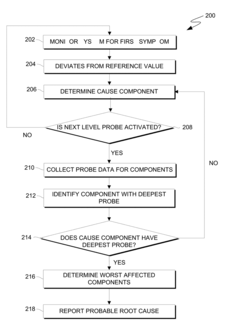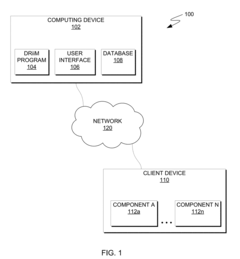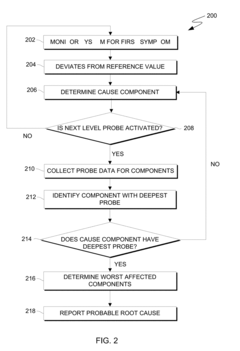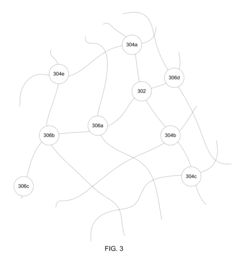Integrated System Monitoring And Diagnostics - Eureka
JUN 17, 20254 MIN READ
Generate Your Research Report Instantly with AI Agent
Patsnap Eureka helps you evaluate technical feasibility & market potential.
Integrated System Monitoring Goals and Background
The primary objective is to develop an integrated system monitoring and diagnostics solution that can proactively detect and diagnose potential issues across various components and subsystems within a complex system. This technology aims to enhance system reliability, reduce downtime, and optimize maintenance efforts.
Key goals include real-time monitoring of system performance, early identification of anomalies or deviations from expected behavior, and accurate root cause analysis through advanced diagnostics techniques. The solution should provide a comprehensive view of the system's health, enabling timely interventions and preventive maintenance actions.
Key goals include real-time monitoring of system performance, early identification of anomalies or deviations from expected behavior, and accurate root cause analysis through advanced diagnostics techniques. The solution should provide a comprehensive view of the system's health, enabling timely interventions and preventive maintenance actions.
Market Demand for System Diagnostics
- Growing Demand for System Monitoring
As systems become more complex, the need for comprehensive monitoring and diagnostics increases. Downtime and performance issues can lead to significant financial losses and reputational damage. - Compliance and Regulatory Requirements
Many industries, such as finance, healthcare, and critical infrastructure, have strict regulations and compliance standards that mandate robust system monitoring and diagnostics. - Cost Optimization and Operational Efficiency
Effective system monitoring and diagnostics can help organizations optimize resource utilization, reduce maintenance costs, and improve overall operational efficiency. - Proactive Issue Detection and Resolution
By monitoring system health and performance metrics, organizations can proactively identify and address potential issues before they escalate into major incidents or outages. - Increased Adoption of Cloud and Distributed Systems
With the rise of cloud computing and distributed systems, the need for comprehensive monitoring and diagnostics across multiple environments and platforms has become more critical.
Current State and Challenges in System Monitoring
- Monitoring Challenges
Complex systems pose significant monitoring challenges due to their intricate architecture, distributed components, and dynamic behavior. Capturing comprehensive system data and correlating events across multiple layers is difficult. - Data Volume and Velocity
Modern systems generate massive volumes of monitoring data at high velocities, straining traditional monitoring tools and storage solutions. Handling this data deluge efficiently is a key challenge. - Heterogeneous Environments
Systems often comprise diverse hardware, software, and infrastructure components from multiple vendors, complicating unified monitoring and diagnostics across the heterogeneous environment. - Root Cause Analysis
Identifying the root cause of system issues is complex due to the intricate dependencies and interactions between components. Advanced analytics and correlation techniques are required. - Real-Time Diagnostics
Detecting and diagnosing issues in real-time is crucial for minimizing system downtime and ensuring optimal performance. However, achieving this in large-scale systems is challenging.
Existing Solutions for System Monitoring
01 System Diagnostics and Monitoring
Techniques for monitoring and diagnosing systems, including data collection, analysis, and insights into system health, performance, and potential issues.- System Diagnostics and Monitoring: Systems and methods for monitoring and diagnosing systems, including anomaly detection, fault identification, performance issue analysis, and diagnostic information for troubleshooting and maintenance.
- Vehicle Diagnostics and Monitoring: Systems and methods for monitoring and diagnosing vehicles, including on-board diagnostics (OBD), diagnostics for vehicle components, and remote monitoring and diagnostics for vehicle fleets.
- Network and System Diagnostics: Techniques for monitoring and diagnosing computer networks, servers, and IT systems, including network traffic analysis, performance bottleneck identification, and diagnostics for system components and applications.
- Industrial Systems Diagnostics and Monitoring: Systems and methods for monitoring and diagnosing industrial equipment, machinery, and processes, including condition monitoring, predictive maintenance, and diagnostics for various industrial applications.
- Medical Device Diagnostics and Monitoring: Systems and methods for monitoring and diagnosing medical devices and instruments, including data acquisition, analysis, and transmission of diagnostic information for various medical applications.
02 Vehicle Diagnostics and Monitoring
Systems and methods for monitoring and diagnosing vehicles, including on-board diagnostics (OBD), monitoring vehicle components and systems, and providing diagnostic information.Expand Specific Solutions03 Network and System Diagnostics
Techniques for monitoring and diagnosing computer networks, servers, and IT systems, including data collection, network traffic analysis, and identifying potential problems or bottlenecks.Expand Specific Solutions04 Industrial Systems Diagnostics and Monitoring
Systems and methods for monitoring and diagnosing industrial equipment, machinery, and processes, including data collection from sensors, anomaly detection, and diagnostic information for maintenance and optimization.Expand Specific Solutions05 Software and Application Diagnostics
Techniques for monitoring and diagnosing software applications, including runtime data collection, application behavior analysis, and identifying potential bugs or performance issues.Expand Specific Solutions
Key Players in System Diagnostics Industry
The competitive landscape for Integrated System Monitoring and Diagnostics is characterized by a mix of established players and emerging companies. The industry is in a growth phase with increasing market demand driven by the need for enhanced system reliability and efficiency.
State Grid Corp. of China
Technical Solution: State Grid Corp. of China has developed an integrated platform leveraging data analytics and machine learning for predictive maintenance and real-time monitoring.
Strength: Advanced data analytics and machine learning. Weakness: High implementation cost.
Robert Bosch GmbH
Technical Solution: Robert Bosch GmbH offers an IoT-enabled solution with cloud-based data processing and AI-driven analytics for predictive maintenance and real-time diagnostics.
Strength: IoT and AI integration. Weakness: Requires significant infrastructure investment.
Core Innovations in System Diagnostics
Dynamic monitoring and problem resolution
PatentActiveUS20180210775A1
Innovation
- Integration of monitoring tiers: the scheme includes a method to monitor an it environment for a first symptom based on a measurement of an attribute of a component. when a deviation from a reference value is detected, the method determines if the component is the cause of the first symptom and activates the appropriate monitoring tier accordingly. this allows for a hierarchical approach to monitoring and troubleshooting system issues.
- Identification of affected components: the scheme includes a step to identify components of the system with the greatest number of activated monitoring tiers. this information can be valuable for prioritizing monitoring and troubleshooting efforts, as well as for understanding the overall health and performance of the system.
- Root cause analysis: the scheme includes program instructions to report the root cause of the first symptom based on probe data and a probe ripple. the probe ripple represents the affected components of the system and how they are affected by the malfunction. by understanding the relationships between components and their status, the system can better diagnose and resolve issues.
Regulatory Landscape for System Diagnostics
Integrated system monitoring and diagnostics is a critical technology for ensuring the reliable and efficient operation of complex systems. It involves the continuous monitoring of various system components and processes, as well as the analysis of collected data to detect anomalies, identify root causes, and provide actionable insights for maintenance and optimization.
The market demand for this technology is driven by the increasing complexity of modern systems, the need for improved operational efficiency, and the growing emphasis on predictive maintenance. Key applications include manufacturing, energy, transportation, and critical infrastructure sectors where system downtime can result in significant financial losses and safety risks.
The current state of the art in integrated system monitoring and diagnostics involves the integration of various technologies, such as sensor networks, data acquisition systems, machine learning algorithms, and visualization tools. However, challenges remain in areas such as data integration, real-time analysis, and the development of robust and scalable diagnostic models.
Environmental Impact of System Monitoring Technologies
Integrated system monitoring and diagnostics is a critical technology for ensuring the reliable and efficient operation of complex systems. It involves the continuous monitoring of various system components and processes, as well as the analysis of collected data to detect anomalies, diagnose root causes, and predict potential failures. This technology has applications across diverse industries, including manufacturing, energy, transportation, and healthcare. By enabling proactive maintenance and optimizing system performance, it can significantly reduce operational costs and downtime, while enhancing safety and productivity. The market demand for integrated system monitoring and diagnostics is driven by the increasing complexity of modern systems and the need for real-time monitoring and predictive analytics. Key challenges include data integration from heterogeneous sources, developing advanced diagnostic algorithms, and ensuring scalability and interoperability across different systems and platforms.
Unlock deeper insights with Patsnap Eureka Quick Research — get a full tech report to explore trends and direct your research. Try now!
Generate Your Research Report Instantly with AI Agent
Supercharge your innovation with Patsnap Eureka AI Agent Platform!



